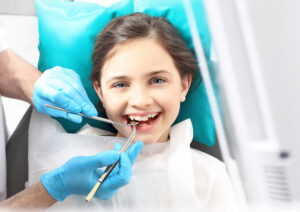A healthy smile begins in childhood. Pediatric dentistry focuses on the oral health of children from infancy through their teenage years, ensuring that they develop strong, healthy teeth and gums. Establishing good dental habits early can prevent future dental problems and contribute to overall well-being. In this article, we will explore the key aspects of pediatric dentistry, including dental development, common issues, oral hygiene habits, and available treatments.
Children’s Dental Development: Stages and Milestones
Understanding your child’s dental development is crucial for ensuring their teeth grow properly. Monitoring development helps parents anticipate changes and address any concerns promptly.
The Teething Process
Teething typically begins around six months of age, but it can start as early as three months or as late as one year. Common signs of teething include drooling, irritability, and a desire to chew on objects. To soothe your child’s discomfort, you can offer teething rings or gently massage their gums with a clean finger.
Primary vs. Permanent Teeth
Children usually have 20 primary (baby) teeth that will eventually be replaced by 32 permanent teeth. Baby teeth are essential for proper chewing, speech development, and maintaining space for permanent teeth. Proper care of primary teeth sets the foundation for a lifetime of good oral health.
Milestones for Tooth Eruption
Most children begin to lose their baby teeth around age six, making way for permanent teeth. However, the timeline can vary. By age twelve, most children have their full set of permanent teeth, excluding the wisdom teeth, which emerge later.
Common Dental Issues During Development
Early childhood caries (tooth decay) and misalignment are common issues during dental development. Addressing these problems early with preventive measures can save your child from more serious dental procedures in the future.
Supporting Healthy Dental Development
Parents can support their child’s dental development by encouraging effective brushing techniques, limiting sugary snacks, and scheduling regular dental check-ups. These practices help ensure that your child’s teeth grow strong and healthy.
Preventing and Managing Common Pediatric Dental Issues
Preventing and managing dental issues early on is vital for maintaining your child’s oral health. Implementing effective prevention strategies can significantly reduce the risk of common dental problems.
Early Childhood Caries
Early Childhood Caries, or tooth decay in young children, is a significant concern. It is primarily caused by frequent consumption of sugary foods and inadequate brushing. Preventive measures such as fluoride treatments and dental sealants can protect your child’s teeth from decay.
Thumb Sucking and Pacifier Use
Prolonged thumb sucking or pacifier use can affect dental alignment, leading to issues like overbite or open bite. Strategies to wean children off these habits include positive reinforcement and gradually limiting their use.
Managing Dental Trauma
Children are active and accidents can happen, leading to dental injuries. Knowing first aid for dental trauma, such as how to handle a knocked-out tooth, can make a significant difference. Seeking immediate dental care is essential to increase the chances of saving the tooth.
Preventive Measures: Sealants and Fluoride Treatments
Dental sealants provide a protective barrier against cavities, especially on the chewing surfaces of molars. Fluoride treatments strengthen enamel, making teeth more resistant to decay. These preventive measures are simple yet effective ways to maintain your child’s dental health.
When to Seek Professional Dental Care
Regular dental check-ups are important, but there are specific signs that indicate the need for a dental visit. These include persistent tooth pain, bleeding gums, or visible signs of decay. Early intervention can prevent minor issues from becoming major problems.

Establishing Good Oral Hygiene Habits in Kids
Good oral hygiene habits developed in childhood can lead to a lifetime of healthy smiles. Teaching proper hygiene practices ensures that children maintain excellent dental health as they grow.
Importance of Early Oral Hygiene Habits
Establishing oral hygiene habits early ensures that children understand the importance of dental care. These habits, such as brushing and flossing, help prevent cavities and gum disease, promoting overall health.
Brushing Techniques for Children
Teaching your child the correct brushing technique is essential. Use a soft-bristled toothbrush and fluoride toothpaste, guiding them to brush for at least two minutes twice a day. Supervising their brushing until they develop the skill ensures they are doing it effectively.
The Role of Flossing
Flossing removes plaque and food particles between teeth where a toothbrush can’t reach. Introduce flossing when your child has two teeth that touch. Make it a fun routine to encourage consistent practice.
Making Oral Care Fun
Making oral care enjoyable can help children develop a positive attitude towards dental hygiene. Use colorful toothbrushes, play their favorite songs while brushing, or use stickers and rewards to motivate them.
Dietary Considerations for Healthy Teeth
A balanced diet plays a crucial role in dental health. Encourage your child to eat foods rich in calcium and vitamins, such as milk, cheese, and leafy greens. Limit sugary snacks and beverages that contribute to tooth decay.
Regular Dental Check-ups
Regular dental check-ups are important for monitoring your child’s oral health. These visits allow the dentist to identify and address any issues early, ensuring that your child’s teeth remain healthy and strong.
Pediatric Dental Treatments: Options and Best Practices
When dental issues arise, various treatment options are available to ensure your child’s comfort and oral health. Understanding the available treatments helps parents make informed decisions about their child’s dental care.
Preventive Treatments: Sealants and Fluoride
Preventive treatments like sealants and fluoride applications are effective in protecting your child’s teeth from decay. Sealants cover the grooves of molars, while fluoride strengthens the enamel, making teeth more resistant to cavities.
Restorative Treatments: Fillings and Crowns
When cavities occur, restorative treatments such as fillings or crowns may be necessary. Tooth-colored fillings are often preferred for their natural appearance, while stainless steel crowns are used for restoring severely damaged teeth.
Orthodontic Options for Children
Early orthodontic evaluations can identify potential alignment issues before they become severe. Treatment options like braces or clear aligners can correct misalignments, ensuring a straight and healthy smile.
Sedation Dentistry
For children with dental anxiety or those undergoing extensive procedures, sedation dentistry can ensure a comfortable experience. Various sedation methods are available, tailored to each child’s needs and ensuring their safety throughout the treatment.
Best Practices for Pediatric Dental Care
Choosing the best dental clinic for your child involves selecting a dentist who specializes in pediatric care, creating a positive dental experience, and maintaining consistent oral hygiene practices at home. These best practices ensure that your child’s dental visits are stress-free and beneficial for their long-term oral health.
Conclusion
Pediatric dentistry plays a vital role in ensuring that children develop healthy, strong teeth and maintain excellent oral hygiene habits. By understanding development, implementing effective prevention, establishing good hygiene practices, and utilizing appropriate treatments, parents can support their children in achieving a lifetime of healthy smiles.


